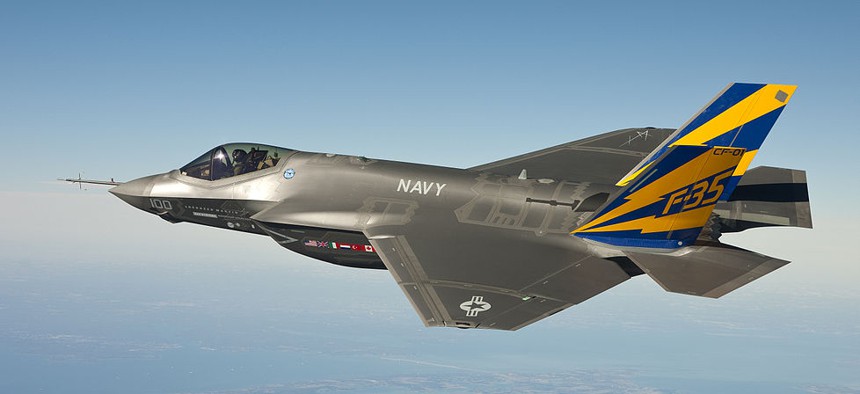
An F-35 B in flight. BAE Systems Inc. is one of many contractors involved in the plane's construction U.S. Navy via Wikimedia Commons
How BAE Systems Execs are Surviving Sequester: Shadeless Airline Windows
Two BAE Systems executive VPs say that they're pivoting away from uncertain U.S. defense dollars and moving into commercial and foreign markes, or "portfolio shaping". By Sara Sorcher
As the defense budget shrinks, industry is being forced to adjust its strategies. Tom Arseneault and David Herr, executive vice presidents for products and services, respectively, at BAE Systems, speak with National Journal Daily about the challenges. Edited excerpts follow.
NJD: What’s the mood now, compared with the last defense downturn after the end of the Cold War?
Arseneault: It feels similar to the early ’90s. What’s different this time, which makes it very difficult, is a real lack of clarity on exactly how [the defense budget] is going to come down. The whole indiscriminate nature of sequester doesn’t fit with what the Defense Department would like to do in the face of smaller budgets, as they did in the ’90s, which is to focus on areas they knew were important.
Herr: The last downturn, that’s when a lot of the consolidation happened, after what’s called the “Last Supper,” when all the defense contractors [met in 1993]. Now that those big companies exist, the consolidation will probably happen at a mid-tier level. It’s not going to be as easy for the industry to consolidate.
NJD: What types of consolidation do you expect?
Herr: The big firms [Lockheed Martin, Northrop Grumman, BAE, and, to some extent, General Dynamics] are going to do some portfolio-shaping for what they want to look like when the market turns. If you look at the service business today, there are not a lot of big, strong, dominant players, and a lot of consolidation is going to happen in that area. It will probably create some very big players—people interested in IT business, maintaining hardware, maintaining space systems. If you look at the history, in the last downturn those companies that sat back and did nothing fared the worst. There will be consolidators and those that will be consolidated. So we’d like to be one of the consolidators.
NJD: How are you positioning your business for the budget cuts?
Herr: We’re [reducing costs], growing our export opportunities, and getting into some commercial space. For example, we repair Navy ships—and in those same yards we do a lot of work [on ships that support] the oil and gas industry down in the Gulf.
Arseneault: Commercial aircraft and electronics is something we do. Now we’re getting involved in next-generation cabin electronics. Someday you’ll fly in an airplane, and instead of shutters on the window, the window will go opaque—polarize the glass so you can’t see through it anymore. Or seat controls, like when the flight attendant says everyone needs to sit in an upright position, all the seats could be tied in. We’re working on these with the intent of selling into that market.
NJD: BAE has the resources to expand into the commercial sphere, but smaller companies aren’t so fortunate. What happens if your suppliers crumble?
Herr: We’ve brought some of those subcontractors as we go visit people on the Hill, and we tell [policymakers], “Clearly, this is going to be the impact on this industry: You’re going to lose certain skills and capabilities.” We try to help [companies] look at consolidations, or [find] other work we can give them. But in a lot of cases, it’s not really possible, because they’re very specialized. It’s not just about a factory in a city in Pennsylvania or Ohio. The supply chain, that’s the crux of the matter—if some of these capabilities go away, we may never get them back.
Arseneault: [The big companies have] enough inertia to be around for a while, with enough backlogs [in orders]. When you start making it down to the fifth- or sixth-tier [suppliers], I’m not sure what happens there. They could just go away. This is a big fear of everyone else up the chain: that someday, we’ll muscle through this sequestration and budget downturn, and when we put out a request for bids, there won’t be anyone there to fill them.
NJD: The Bradley Fighting Vehicle seems like a good example of the aftermath of leaving ground wars. The Army’s funding plan would close the production line for three years.
Arseneault: What do you do with one of the two premier military vehicle-building facilities in the country, so we’ll have that capability, if God forbid, we need it again quickly? What does it take to keep the skills employed, keep the assets—things like refitting Bradleys coming back, getting them ready for the next fight, should there be one?
NJD: How does BAE read the tea leaves?
Arseneault: We’re now coming out of Iraq and Afghanistan, and the threats as we perceive them are over in the Pacific Rim and places like North Korea. The threat China presents, not overtly but in the long run, because of their military buildup, becomes of concern. The so-called pivot to the Pacific becomes something that people can grasp, to say, “When focus finally comes [on defense], it will come in that form—so how do we line ourselves up to focus on the types of systems that will be useful?” We have a legacy of capability in electronic warfare. If the bad guys are looking through airplanes using radar, we use electronic-attack [capability] to hide, make it think we’re over there when we’re really over here. Those are more-sophisticated things we want to focus on.
Herr: A lot of ships are going to move West, so we’re enhancing our shipyards on the West Coast.




